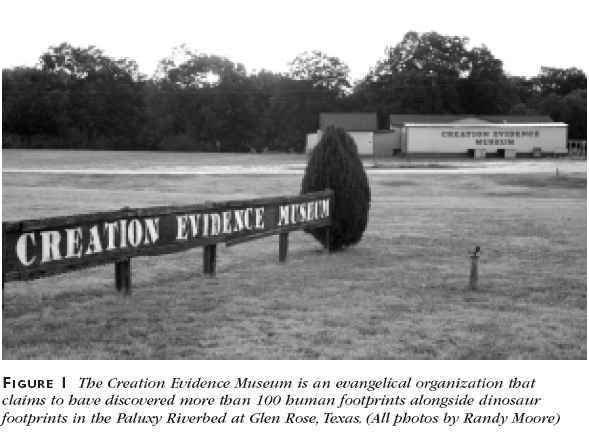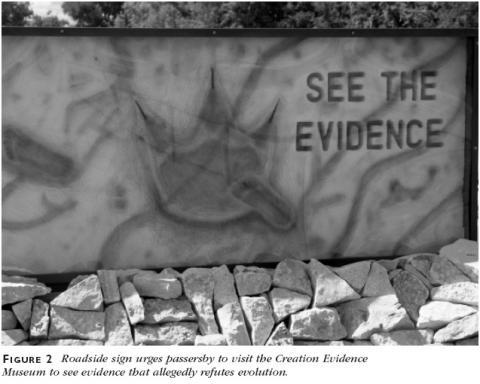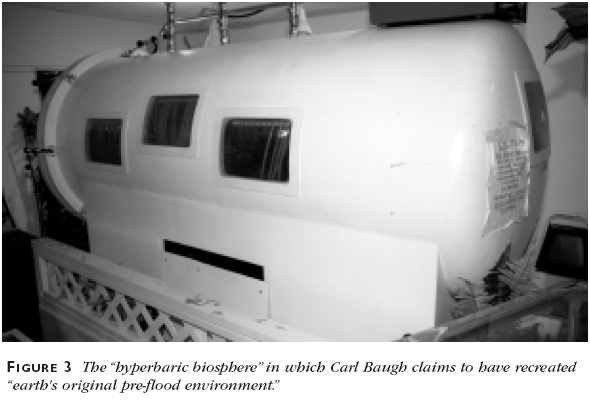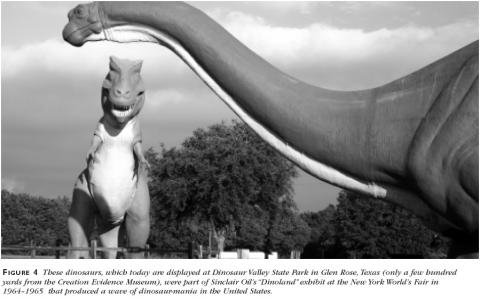
People driving along Highway 205 on their way to Dinosaur Valley State Park just outside of scenic Glen Rose,Texas, are often surprised to encounter the Creation Evidence Museum, located just a few hundred yards before the park's entrance (Figures 1, 2). The popular museum consists of a small group of trailers and a larger building that advertises itself as a "scientifically chartered museum." The museum's founder is Carl Baugh, a Baptist preacher, archaeologist,and Trinity Broadcasting Network personality who uses the museum to discredit evolution by claiming that people lived contemporaneously with dinosaurs. Baugh began his excavations along the nearby Paluxy River on March 15, 1982, and two days later announced discoveries of human and dinosaur tracks having "unparalleled historic significance".

In the museum, visitors watch a 40-minute Creation in Symphony video in which Baugh describes his story of creation that includes water's being sprayed 70 miles into the air and God's stretching the "space fabric" to a point where faraway stars exploded. Baugh, a young-earth creationist, claims that evolution offers no explanation for our existence. Baugh's creationism, on the other hand, provides hope and a happier ending. The museum, which was established in 1984, supports a variety of research programs, including expeditions that claim to have found living pterodactyls in New Guinea.
Museum officials claim that the fossilized human footprints displayed in the Museum were made in what people have been "educated" to believe are 113-million-year–old deposits of limestone in nearby Dinosaur Valley State Park. Baugh claims to have excavated almost 100 footprints and 475 dinosaur footprints. Researchers in nearby Dinosaur Valley State Park have found thousands of dinosaur tracks, but no contemporaneous human footprints.
One of the largest footprints on display at the Creation Evidence Museum — the 14" (36 cm)-long "Burdick Track" — was found by the energetic Clifford Burdick (1894–1992), a founder of the Deluge Society, one of America's first creationist groups. Burdick went to Glen Rose (about 50 miles southwest of Fort Worth) late in 1949, and in 1950 published an article titled "When giants roamed the earth" in the Seventh-Day Adventist magazine Signs of the Times. In that article, Burdick proclaimed that the Paluxy tracks were made by humans and that they therefore refute evolution. Burdick's article used out-of-context quotes to suggest that famed fossil-hunter Roland Bird (who went to Glen Rose in 1938 to investigate the tracks) had excavated the tracks and believed that they were made by humans.
Footprints from the Paluxy site were subsequently featured in The Genesis Flood, a book by Henry Morris and John Whitcomb Jr, that in 1961 launched the modern "creation science" movement in the United States. The tracks were promoted by numerous books (such as AE Wilder-Smith's Man's Origin, Man's Destiny in 1965) and films (Baptist minister Stanley Taylor's Footprints in Stone, produced with the help of Henry Morris in 1972). However, all of the tracks allegedly made by humans have been discredited by numerous studies.
The "Burdick Track" was not Burdick's only major discovery; in 1966, Burdick described his alleged discovery of pollen from conifers in Precambrian rocks as "science-shaking original-pioneering work." However, this discovery — like the "Burdick Track" — was later discredited by scientists; and even some creationists began to distance themselves from Burdick's claims. For example, young-earth creationist Walter Lammerts (1904–1996) — whose work was also cited in The Genesis Flood — criticized Burdick as someone who was "weak", "slow", and who "has not kept up with his reading". Unlike many creationists of his era, Lammerts supported civil rights and conservation, abhorred far-right extremists, and rejected the claim that communism was based on evolution. Lammerts's approach to the evolution controversy was simple: "If a man is such a stupid fool he can't see that evolution is wrong, I'm not going to try to convince him."

The Creation Evidence Museum also includes a large magenta-windowed "hyperbaric biosphere" in which Baugh claims to have recreated "earth's original pre-flood environment" (Figure 3). According to Baugh, the biosphere — which is connected to an oscilloscope — increases organisms' life-spans by 300%; it also detoxifies copperheads' venom. Near the biosphere is an aquarium in which Baugh grows "vegetarian piranhas." Baugh believes his discoveries support the vast life-spans of biblical patriarchs such as Adam (who allegedly lived to be 930), and the harmonious environment (that is, no carnivores or death) before Eve introduced sin into the world. Baugh hopes to grow dinosaurs in the biosphere. On the museum's walls, visitors can view paintings in which pre-flood children play with a baby Apatosaurus in the nearby Paluxy River.Visitors can purchase these replicas, as well as books, posters, and other materials such as certificates honoring recipients as "visionaries" for "supporting truth in education."

The dinosaur tracks in Glen Rose are from the lower Cretaceous; some of these tracks that were studied by Roland Bird are also displayed at the American Museum of Natural History. The 1500-acre Dinosaur Valley State Park — a National Natural Landmark — includes models of a 70' (21 m) Apatosaurus and a 45' (14 m) Tyrannosaurus rex commissioned by the Sinclair Oil Company for the New York World's Fair in 1964–1965 (Figure 4).
